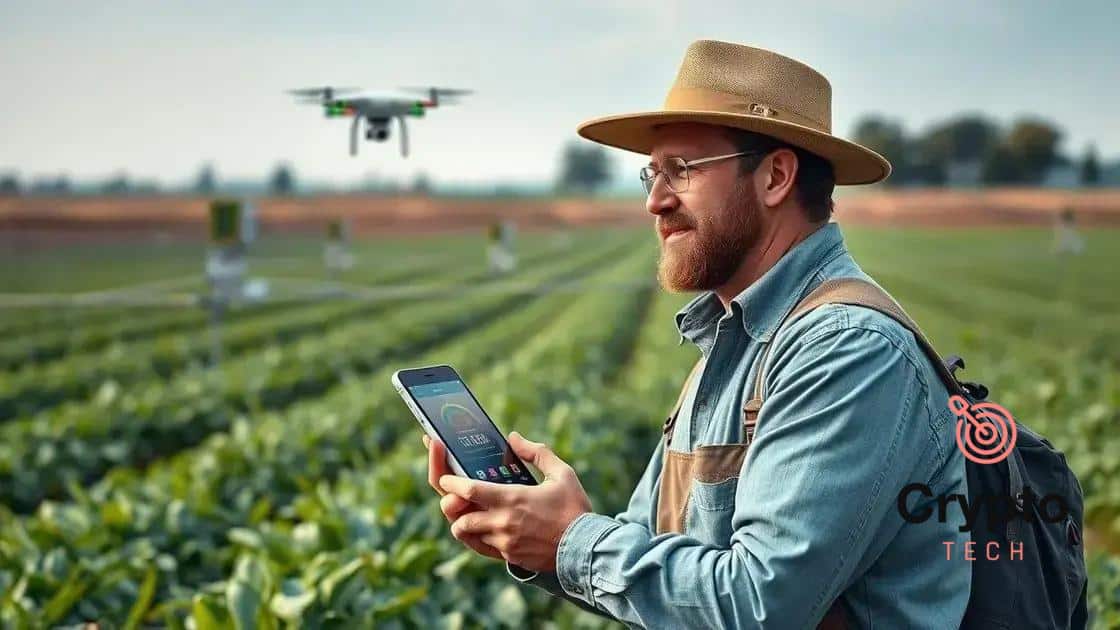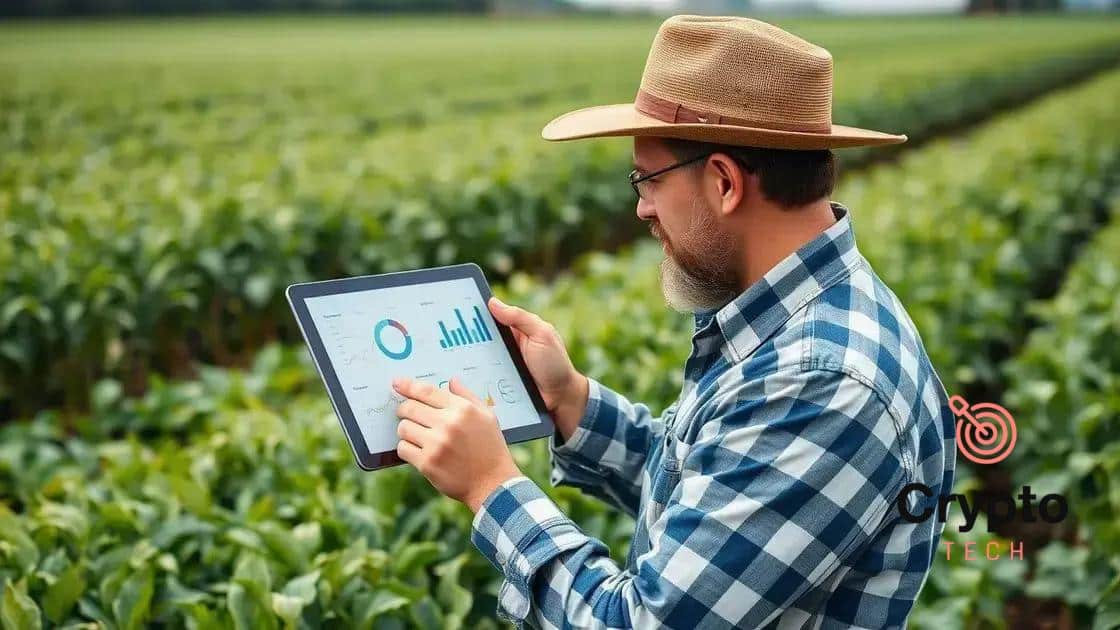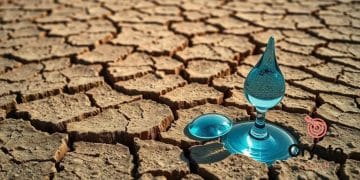AI in agriculture helping fight food insecurity

AI in agriculture helps fight food insecurity by optimizing crop yields, enhancing pest control, and improving resource management through data-driven technologies.
AI in agriculture helping fight food insecurity is not just a buzzword. It represents a new frontier in how we approach the challenges of food production and sustainability. Have you ever wondered how technology can improve the yields of our farms?
How AI is enhancing crop yields
AI is playing a crucial role in enhancing crop yields. By analyzing various data points, farmers can make informed decisions that lead to better productivity. Artificial intelligence helps in predicting weather patterns, optimizing irrigation, and improving soil health.
Weather Prediction and Analysis
Accurate weather prediction is essential for successful farming. AI uses historical weather data and current trends to forecast future conditions. This information allows farmers to:
- Plan sowing and harvesting times effectively.
- Adjust irrigation levels based on predicted rainfall.
- Reduce risks associated with unexpected weather events.
Moreover, understanding the weather can greatly influence the types of crops chosen for planting. With AI’s assistance, farmers can select varieties that thrive in projected conditions.
Optimizing Irrigation
Water is a precious resource in agriculture. AI systems can monitor soil moisture levels in real-time. This capability helps farmers optimize their irrigation practices, ensuring that crops receive adequate water without over-watering. Some benefits include:
- Lower water usage and conservation of resources.
- Enhanced growth rates and healthier plants.
- Increased resistance to drought.
Focusing on efficient irrigation not only saves water but also supports sustainable farming practices.
AI is also able to analyze nutrient requirements for different crops. By providing tailored recommendations, it helps farmers apply the right nutrients in the right amounts, leading to improved crop health and higher yields. Additionally, precision agriculture tools powered by AI create maps that identify the variability in fields, allowing for targeted interventions where needed. This results in optimized crop performance across entire fields.
Soil Health Management
Incorporating AI into soil management leads to more productive and sustainable farming. By analyzing soil quality and nutrient composition, farmers can:
- Make informed decisions about fertilizers and amendments.
- Monitor soil erosion and implement preventive measures.
- Utilize crop rotation strategies effectively.
This careful management of soil health not only enhances yields but also promotes longevity in farming practices.
The role of AI in resource management

AI plays a significant role in resource management within agriculture, allowing farmers to utilize their resources more efficiently. By leveraging data analytics, farmers can ensure that every drop of water, every ounce of fertilizer, and every minute of labor is used wisely.
Water Management
Water is one of the most critical resources in farming. AI systems help monitor and manage water usage by analyzing weather patterns and soil moisture levels. This ensures crops receive the right amount of water when they need it. Benefits include:
- Reduced water waste through precise irrigation systems.
- Improved crop health by maintaining optimal moisture levels.
- Greater resilience against drought conditions.
Optimizing water management can lead to significant cost savings and environmental protection.
Energy Efficiency
AI is also enhancing energy efficiency in agriculture. By using sensors and smart technology, farmers can monitor energy consumption and find ways to reduce it. For instance, AI can identify how much energy different machinery uses throughout the day. This allows farmers to:
- Schedule high-energy tasks during off-peak hours.
- Use more energy-efficient equipment.
- Lower overall operational costs.
By improving energy efficiency, farmers not only cut costs but also contribute to sustainability.
Managing fertilizers and pesticides is another area where AI shines. With precise data analysis, farmers can apply the appropriate amounts at the right times. This minimizes waste and maximizes effectiveness, ensuring that crops get what they need without damaging the environment. Furthermore, AI can help predict pest outbreaks, allowing for timely intervention and resource allocation.
Data-Driven Decision Making
Overall, leveraging AI for resource management leads to better decision-making. Farmers can analyze trends from past crop cycles and adjust their strategies accordingly. This data-driven approach helps them respond quickly to changes, making agriculture more adaptable and efficient.
AI applications in pest control
AI applications in pest control are revolutionizing how farmers manage crop health. By utilizing machine learning and advanced imaging techniques, farmers can detect pest problems early and take action swiftly. This not only saves crops but also reduces the need for harmful chemicals.
Early Detection of Pests
One of the most impressive benefits of AI in pest control is its ability to identify pests in the early stages. Using drones equipped with cameras, farmers can monitor their fields from above, capturing high-resolution images. Through image recognition, AI systems can analyze these images to:
- Detect pest infestations before they spread.
- Identify specific pest species for targeted treatment.
- Monitor crop conditions and health.
By detecting pests early, farmers can implement strategies that minimize damage and ensure healthier harvests.
Precision Spraying Techniques
With AI, farmers can enhance their spraying techniques. Automated systems can calculate the exact amount of pesticide needed based on pest density and type, reducing waste and minimizing the impact on non-target species. Some advantages of this approach include:
- Lower quantities of chemicals used, reducing costs.
- Less environmental impact from pesticide runoff.
- Increased effectiveness as the right amount is applied to the right place.
This precision helps to improve the overall sustainability of agricultural practices. Moreover, AI can help determine the best times to apply treatments, considering environmental conditions and pest life cycles.
AI also aids in analyzing pest behavior, utilizing data from multiple seasons to predict outbreaks. By understanding how pests behave over time, farmers can develop better management strategies. Insights gained allow for proactive measures rather than reactive responses, empowering farmers to combat infestations more effectively.
Integrating AI with Integrated Pest Management (IPM)
AI complements traditional integrated pest management (IPM) practices by providing valuable data and insights. IPM focuses on using a wide range of practices aimed at pest prevention and control. With AI analytics, farmers can combine data on weather patterns, pest populations, and crop health to create a comprehensive management plan. This synergy leads to smarter, data-driven decisions in pest control.
Predictive analytics for better harvests

Predictive analytics plays a vital role in achieving better harvests in agriculture. By analyzing vast amounts of data, farmers can make informed decisions that lead to improved crop yields. This technology enables them to anticipate potential challenges and adapt their strategies accordingly.
Understanding Predictive Analytics
Predictive analytics involves using historical data, statistical algorithms, and machine learning techniques to forecast future events. In agriculture, it examines trends based on past weather patterns, soil conditions, and crop performance. This helps farmers:
- Forecast potential yield outcomes.
- Prepare for unforeseen weather events.
- Optimize planting schedules.
With this knowledge, farmers can plan effectively and allocate resources where they are most needed.
Weather Forecasting and Crop Planning
One of the key aspects of predictive analytics is accurate weather forecasting. By analyzing climatic data, farmers can predict weather-related challenges such as droughts or heavy rainfall. This insight allows them to:
- Select the best times for planting and harvesting.
- Adjust irrigation practices based on expected rainfall.
- Choose crop varieties suitable for expected conditions.
By aligning their agricultural practices with weather predictions, farmers can mitigate risks and enhance their overall productivity.
In addition to weather, predictive analytics looks at soil health and nutrient levels. By analyzing soil data, farmers gain insights into which nutrients are needed and when to apply them. This targeted approach ensures that crops receive what they need for optimal growth, leading to healthier plants and larger harvests.
Real-time Data and Decision Making
Real-time data collection from sensors also contributes to predictive analytics. Soil moisture sensors and satellite imagery provide immediate feedback on crop condition and environmental factors. This information enables farmers to:
- Make timely adjustments to their farming practices.
- Respond quickly to emerging pest threats.
- Maximize resource use efficiency.
Combining real-time data with predictive analytics enables farmers to stay one step ahead, ensuring better management of their fields.
Real-world examples of AI in farming
Real-world examples of AI in farming illustrate how technology can enhance productivity and sustainability. Farmers and agricultural companies worldwide are adopting AI to improve crop management, reduce waste, and increase yields.
Precision Agriculture
One notable application is precision agriculture. Farmers use AI to analyze data from various sources, like soil sensors and satellite imagery, to optimize their farming practices. This data helps them understand which areas of their farms require more attention. Some key benefits include:
- Targeted use of fertilizers and pesticides.
- Irrigation adjustments based on soil moisture levels.
- Increased crop yields through precise management.
By leveraging AI, farmers make informed decisions that lead to higher efficiency and lower costs.
Robotic Harvesting
Another exciting example is the use of robotic harvesting systems. Companies like Harvest Croo have developed robots that can pick fruits and vegetables with precision. These robots use AI to identify ripe produce and harvest it while minimizing damage. This innovation leads to:
- Reduced labor costs.
- Higher harvesting efficiency.
- Less food waste from improper handling.
Farmers benefit from consistent and reliable harvesting, ensuring that their products reach the market fresh.
In addition to harvesting, AI is helping farmers monitor crop health. For example, Blue River Technology uses AI-driven equipment to differentiate between crops and weeds. This technology allows farmers to apply herbicides only where needed, significantly reducing chemical use. This not only cuts costs but also promotes sustainable farming practices.
Data-Driven Decision Making
Moreover, companies like Microsoft are developing platforms that integrate AI with agricultural data. These platforms help farmers track their activities, predict weather events, and understand market trends. By having access to this information, farmers can:
- Plan planting and harvesting strategically.
- Adjust their practices based on real-time data.
- Enhance overall productivity and profitability.
Through these real-world applications, AI is reshaping the future of farming, paving the way for smarter, more efficient agricultural practices.
FAQ – Frequently Asked Questions about AI in Agriculture
How does AI improve crop yields?
AI analyzes data from soil, weather, and crop health to help farmers make better decisions, optimizing planting and harvesting.
What role does AI play in pest control?
AI helps in early detection of pests and optimizes pesticide application, reducing waste and environmental impact.
Can robots really harvest crops effectively?
Yes, robotic harvesters use AI to identify and pick ripe fruits and vegetables, improving efficiency and minimizing damage.
How does predictive analytics benefit farming?
Predictive analytics provides insights into weather patterns and crop performance, allowing farmers to plan and respond effectively.





